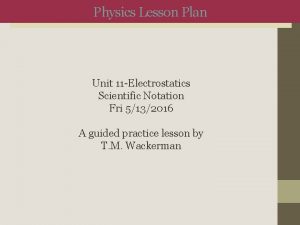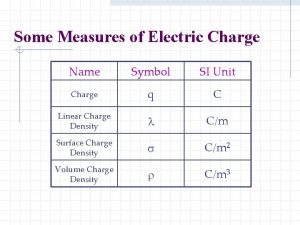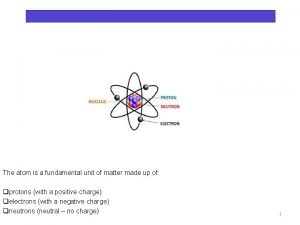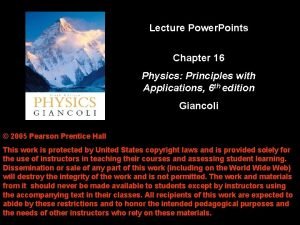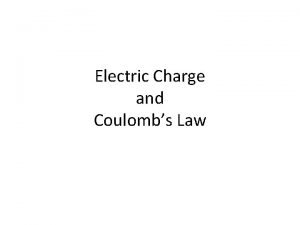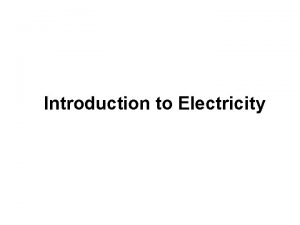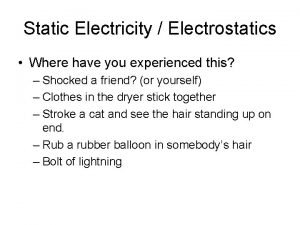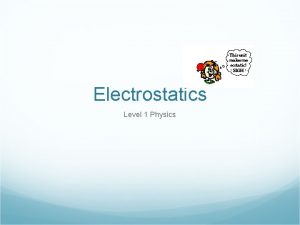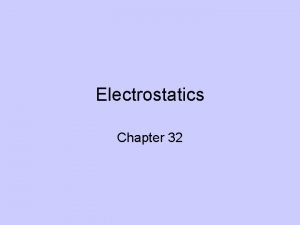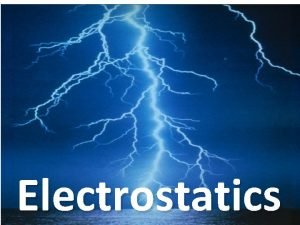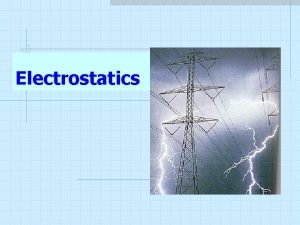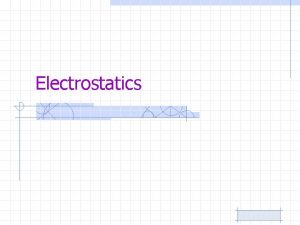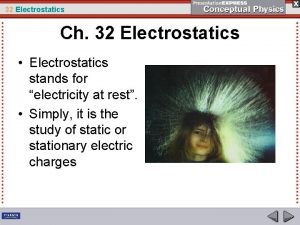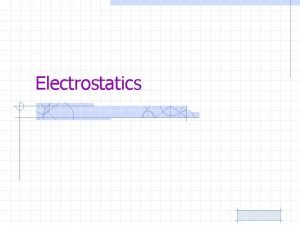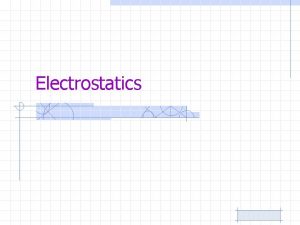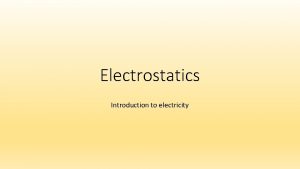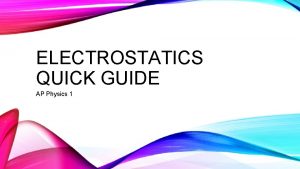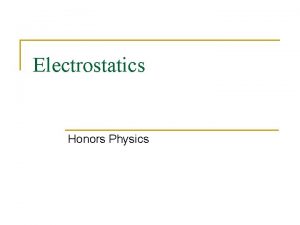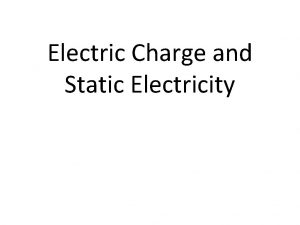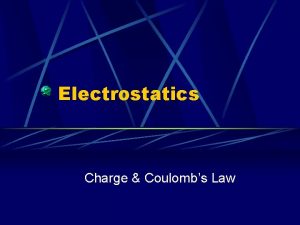Unit 7 Electrostatics Lesson 1 Electric Charge Electric
















- Slides: 16

Unit 7: Electrostatics Lesson 1: Electric Charge

Electric Charge Smallest bits of electric charge: protons and electrons e = elementary charge (charge on one proton/electron) = 1. 6 x 10 -19 Coulombs E. g. How many electrons in one coulomb? 1 C / e = 6. 2 x 1018 electrons

Laws of Electric Charge Like charges repel; opposite charges attract. Charged objects (negative or positive) attract neutral ones. E. g. A negative object repels the electrons at the surface of a neutral object brought near it, thus creating a positive surface that attracts to it. This is called “charging by induction”. Negative object Neutral object

Movement of Electrons Charging by contact: transfer of charge when electrons move from place to place Charging by induction: temporary movement of electrons within an object due to electric forces Demo:

Brain Break!

Like charges repel; unlike charges attract… with how much force? q 1 d q 2 Point charges q = magnitude of charge in coulombs Coulomb’s Law: F = k q 1 q 2 d 2 k = 9. 0 x 109 Nm 2/C 2 “Coulomb’s constant”

Example 1: An electron orbits a proton at a distance of 2. 0 x 10 -11 m. Find: a) The force of attraction. b) The orbital period. Constants: e = 1. 6 x 10 -19 C me = 9. 11 x 10 -31 kg e a) Use Coulomb’s Law, and remember that q is the magnitude of the charge only. b) Use F=ma, and then circular motion. Answers: a) 5. 8 x 10 -7 N, b) 3. 5 x 10 -17 s

Example 2: A small plastic sphere has a known charge of +6. 5 µC. It is attracted to a second small sphere 3. 5 cm away with a force of 0. 023 N. Find: a) The charge on the second sphere. b) The number of excess electrons on the second sphere. a) - = 4. 8 x 10 -10 C negative! b) = 3. 0 x 109 electrons

Homework • Textbook pg. 142 #1 -6

Unit 7: Electrostatics Lesson 2: The Principle of Superposition

The Principle of Superposition The resultant force on any one particle equals the vector sum of all forces on it. Example 1: a) Find the net force on the – 5. 0 C charge. b) Where should that -5. 0 C charge be placed so that the net force is zero? 2. 0 C a) F = F 1 – F 2 + Q 2 -1. 0 C -5. 0 C _ _ 2 m 2 m Q 1 Q 5 _ F 2 F 1

b) 2. 0 C + Q 2 -1. 0 C -5. 0 C _ _ x 2 m Q 1 Q 5 _ F 2 F 1

Example 2: Three +20 µC charges are placed at the corners of an equilateral triangle of side 1. 0 m. Find the force exerted on one charge by the other two. y + F 1 F + + x 30 o F 2 F 1 = F 2 = k(20 x 10 -6)2 1. 02 = 3. 6 N F = 2 x F 1 x = 2 x F 1 cos 30 = 6. 2 N

Brain Break!

Q Fc Q (a) + Q + (b) Fa + db Fb 2 m θ 5 m + (c) Example 3: (Try it!) Find the force on the top right charge. (Q = 40 µC) Q X : Fx = Fa + Fbcosθ 2 2 = k. Q + k. Q cosθ d a 2 d b 2 = k. Q 2 ( 12 + 1 cos 21. 8) 5 29 = 1. 04 N Y : Fy = Fc + Fbsinθ = k. Q 2( 1 2 + 1 sin 21. 8) 2 29 = 3. 78 N F db =√(22 + 52) = √ 29 θ = tan-1(2/5) = 21. 8 o F = √(1. 0422 + 3. 7822) = 3. 9 N θ = tan-1(1. 04/3. 78) = 15 o 3. 9 N, 15 o right of the vertical

Homework • Textbook pg. 142 #7, 8, and 10
 Difference between charge and electric charge
Difference between charge and electric charge Electrons flowing
Electrons flowing Chapter 21 electric charge and electric field
Chapter 21 electric charge and electric field Chapter 21 electric charge and electric field
Chapter 21 electric charge and electric field Units for coulombs
Units for coulombs Dc o/d per item charge
Dc o/d per item charge Electrostatics lesson plan
Electrostatics lesson plan Symbol for electric field strength
Symbol for electric field strength Charge on proton
Charge on proton Unit of electric charge
Unit of electric charge Coulomb's formula
Coulomb's formula What is the symbol of coulomb
What is the symbol of coulomb Electric charges and electric forces lesson outline
Electric charges and electric forces lesson outline Qxa=e
Qxa=e Electric field due to infinitely long straight wire
Electric field due to infinitely long straight wire Induction vs conduction physics
Induction vs conduction physics Electricity at rest
Electricity at rest






